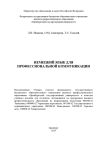
Автор книги: Радмила Шарифьянова
Жанр: Языкознание, Наука и Образование
Возрастные ограничения: +16
сообщить о неприемлемом содержимом
Текущая страница: 1 (всего у книги 8 страниц) [доступный отрывок для чтения: 2 страниц]
Английский для айтишников
Tech English: Язык программистов и IT-специалистов
Радмила Шарифьянова
© Радмила Шарифьянова, 2023
ISBN 978-5-0060-1534-0
Создано в интеллектуальной издательской системе Ridero
Introduction to the Role of an IT Professional
Information Technology (IT) professionals are responsible for managing and maintaining computer systems, networks, and software. They play a crucial role in ensuring that organizations can use technology effectively to achieve their goals.
There are many different job titles within the field of IT. Some common roles include network administrator, who is responsible for managing an organization’s computer network; database administrator, who manages databases that store important company information; system analyst, who evaluates an organization’s technological needs and recommends solutions; and software developer, who designs and creates software programs.
Hardware and software are two key components of computer systems. Hardware refers to the physical components of a computer, such as the central processing unit (CPU), monitor, keyboard, and mouse. Software, on the other hand, refers to the programs and applications that run on a computer system, such as Microsoft Word or Adobe Photoshop.
A firewall is a network security device that monitors incoming and outgoing network traffic and decides whether to allow or block specific traffic based on a set of predefined security rules. Firewalls are important for cybersecurity because they help to protect against unauthorized access and data breaches.
Troubleshooting is the process of identifying and resolving problems in a computer system or software application. A typical troubleshooting process involves identifying the symptoms of a problem, isolating the cause of the problem, and implementing a solution to fix the issue.
Customer support is an essential part of the work of IT professionals. It helps to ensure that users have a positive experience with technology and are able to use it effectively. Good customer support can also help to build trust and loyalty among customers.
Vocabulary
Information Technology (IT) – информационные технологии
Network – сеть
Database – база данных
Hardware – аппаратное обеспечение
Software – программное обеспечение
Operating System (OS) – операционная система
Firewall – брандмауэр
Cybersecurity – кибербезопасность
Troubleshooting – устранение неполадок
Customer support – поддержка клиентов
Tasks
– What is the role of an IT professional and what are some common job titles in this field?
– Define «hardware» and «software» and give an example of each.
– What is a firewall and why is it important for cybersecurity?
– Explain what troubleshooting is and give an example of a troubleshooting process.
– Why is customer support important for IT professionals?
Sample answers:
– An IT professional is responsible for managing and maintaining computer systems, networks, and software. Some common job titles in this field include network administrator, database administrator, system analyst, and software developer.
– Hardware refers to the physical components of a computer system, such as the central processing unit (CPU), monitor, keyboard, and mouse. Software refers to the programs and applications that run on a computer system, such as Microsoft Word or Adobe Photoshop.
– A firewall is a network security device that monitors incoming and outgoing network traffic and decides whether to allow or block specific traffic based on a set of predefined security rules. It is important for cybersecurity because it helps to protect against unauthorized access and data breaches.
– Troubleshooting is the process of identifying and resolving problems in a computer system or software application. An example of a troubleshooting process would be to identify the symptoms of a problem, isolate the cause of the problem, and implement a solution to fix the issue.
– Customer support is important for IT professionals because it helps to ensure that users have a positive experience with technology and are able to use it effectively. Good customer support can also help to build trust and loyalty among customers.
Demystifying Computer Parts: A Comprehensive Guide for IT Specialists
If you’re an IT specialist, understanding computer parts is essential. With this guide, we’ll help you demystify the various components of a computer and what their functions are.
Central Processing Unit (CPU): This is the brain of the computer, responsible for executing instructions and performing calculations.
Random Access Memory (RAM): This is the computer’s short-term memory, storing data that is currently being used by the CPU.
Hard Disk Drive (HDD): This is the computer’s long-term memory, storing data even when the power is off.
Solid State Drive (SSD): Similar to an HDD, but uses flash storage instead of spinning disks, resulting in faster read/write times.
Motherboard: This is the main circuit board that connects all the other components of the computer together.
Graphics Processing Unit (GPU): This is responsible for processing and displaying graphics and images.
Power Supply Unit (PSU): This supplies power to all the components of the computer.
Cooling System: This keeps the computer from overheating by dissipating heat generated from the CPU and GPU.
Vocabulary
1. Demystify – Explain or clarify something that is difficult to understand (Объяснить что-то сложное)
2. Components – Individual parts that make up a larger system (Компоненты)
3. Central Processing Unit (CPU) – The brain of the computer (Центральный процессор)
4. Random Access Memory (RAM) – The computer’s short-term memory (Оперативная память)
5. Hard Disk Drive (HDD) – The computer’s long-term memory (Жесткий диск)
6. Solid State Drive (SSD) – A type of hard drive that uses flash storage (Твердотельный диск)
7. Motherboard – The main circuit board that connects all other components of the computer (Материнская плата)
8. Graphics Processing Unit (GPU) – Responsible for processing and displaying graphics and images (Графический процессор)
9. Power Supply Unit (PSU) – Supplies power to all components of the computer (Блок питания)
10. Cooling System – Keeps the computer from overheating by dissipating heat generated from the CPU and GPU (Система охлаждения)
Tasks
1. Match the following definitions with the correct computer part:
a) The brain of the computer
b) Individual parts that make up a larger system
c) The computer’s short-term memory
d) The computer’s long-term memory
e) A type of hard drive that uses flash storage
i) Central Processing Unit (CPU)
ii) Components
iii) Random Access Memory (RAM)
iv) Hard Disk Drive (HDD)
v) Solid State Drive (SSD)
Answer:
a) Central Processing Unit (CPU)
b) Components
c) Random Access Memory (RAM)
d) Hard Disk Drive (HDD)
e) Solid State Drive (SSD)
2. Fill in the blank with the appropriate vocabulary word:
«Without proper _____, a computer can overheat and damage its components.»
Answer: Cooling System
3. Write a short paragraph explaining the difference between an HDD and SSD.
Answer: While both HDDs and SSDs are used as hard drives for storing data, they differ in how they store and retrieve information. An HDD uses spinning disks to read and write data, while an SSD uses flash memory. Since an SSD has no moving parts, it can access data much faster than an HDD, resulting in quicker boot-up times and file transfers. However, SSDs are typically more expensive than HDDs.
Exploring the Latest Advancements in Hardware
Hardware refers to the physical components of a computer system, including the central processing unit (CPU), memory, storage devices, and peripherals. With advancements in technology, hardware has become faster, more efficient, and more reliable than ever before.
One example of cutting-edge hardware is solid-state drives (SSDs). These storage devices use flash memory instead of spinning disks to store data, resulting in faster read and write speeds and increased durability. Another innovation is the use of artificial intelligence (AI) to enhance hardware performance. AI algorithms can optimize CPU usage, predict system failures, and improve energy efficiency.
The Internet of Things (IoT) has also led to new hardware developments. Devices such as smart thermostats, security cameras, and door locks are now equipped with sensors and connectivity options that enable them to communicate with other devices and systems.
As technology continues to evolve, hardware will play an increasingly crucial role in enabling new applications and services. IT professionals must stay up-to-date with these advancements to ensure they are using the most efficient and effective hardware for their organizations.
Vocabulary
Advancements – продвижения
Components – компоненты
Central processing unit (CPU) – центральный процессор
Memory – память
Storage devices – устройства хранения
Peripherals – периферийные устройства
Cutting-edge – передовой
Solid-state drives (SSDs) – твердотельные накопители
Flash memory – флэш-память
Read and write speeds – скорость чтения и записи
Durability – прочность
Artificial intelligence (AI) – искусственный интеллект
CPU usage – использование процессора
Predict – прогнозировать
System failures – сбои в работе системы
Energy efficiency – энергоэффективность
Internet of Things (IoT) – интернет вещей
Sensors – датчики
Connectivity options – возможности подключения
Security cameras – камеры безопасности
Door locks – замки дверей
Communicate – общаться
Tasks
1. What is the definition of hardware?
Answer: Hardware refers to the physical components of a computer system, including the central processing unit (CPU), memory, storage devices, and peripherals.
2. How do solid-state drives (SSDs) differ from traditional hard disk drives?
Answer: SSDs use flash memory instead of spinning disks to store data, resulting in faster read and write speeds and increased durability.
3. How can artificial intelligence (AI) enhance hardware performance?
Answer: AI algorithms can optimize CPU usage, predict system failures, and improve energy efficiency.
4. What is the Internet of Things (IoT)?
Answer: The Internet of Things (IoT) refers to devices such as smart thermostats, security cameras, and door locks that are equipped with sensors and connectivity options that enable them to communicate with other devices and systems.
5. Why is it important for IT professionals to stay up-to-date with hardware advancements?
Answer: As technology continues to evolve, hardware will play an increasingly crucial role in enabling new applications and services. IT professionals must stay up-to-date with these advancements to ensure they are using the most efficient and effective hardware for their organizations.
Understanding Computer Motherboards
The motherboard is one of the most important components of a computer system, as it connects and controls all other hardware components. It is essentially the «heart» of the computer.
There are several key features to consider when selecting a motherboard. First is the form factor, which refers to the physical size and layout of the board. Common form factors include ATX, Micro-ATX, and Mini-ITX.
Another important consideration is the socket type, which determines what kind of CPU can be installed on the motherboard. The most common CPU sockets are Intel’s LGA and AMD’s PGA.
The chipset is another important component of the motherboard, as it determines what features the board will have, such as the number of USB ports and the maximum amount of RAM that can be installed.
The motherboard also has expansion slots for additional hardware components, such as graphics cards and sound cards. These slots come in different sizes and speeds, such as PCI Express x16 or PCI Express 3.0.
It’s important to note that not all motherboards are compatible with all hardware components. For example, a motherboard with an Intel LGA socket cannot support an AMD processor.
Vocabulary
Motherboard – материнская плата
Hardware components – компоненты аппаратного обеспечения
Connects – соединяет
Controls – управляет
Form factor – форм-фактор
Physical size – физический размер
Layout – расположение
ATX – форм-фактор АТХ
Micro-ATX – форм-фактор Микро-АТХ
Mini-ITX – форм-фактор Мини-АТХ
Socket type – тип сокета
CPU – центральный процессор
Chipset – чипсет
Features – характеристики
USB ports – порты USB
RAM – оперативная память
Expansion slots – слоты расширения
Graphics cards – графические карты
Sound cards – звуковые карты
Sizes – размеры
Speeds – скорости
Compatible – совместимый
Tasks
1. What is the function of a motherboard?
Answer: The motherboard connects and controls all other hardware components in a computer system.
2. What is form factor, and why is it an important consideration when selecting a motherboard?
Answer: Form factor refers to the physical size and layout of the motherboard. It is an important consideration because it determines what kind of case the board can fit in and what hardware components can be installed.
3. What is the socket type, and how does it relate to selecting a CPU for a computer system?
Answer: The socket type determines what kind of CPU can be installed on the motherboard. It is important to select a compatible CPU with the correct socket type for the motherboard.
4. What features does the chipset determine on a motherboard?
Answer: The chipset determines what features the motherboard will have, such as the number of USB ports and the maximum amount of RAM that can be installed.
5. What are expansion slots, and what kind of hardware components can be installed in them?
Answer: Expansion slots are slots on the motherboard for installing additional hardware components, such as graphics cards and sound cards. These slots come in different sizes and speeds, such as PCI Express x16 or PCI Express 3.0.
Understanding Computer Hardware Components
Hardware is the physical components that make up a computer system. These components can be categorized into different types such as input, output, storage, and processing devices.
Input devices are used to enter data and commands into the computer. Examples of input devices include keyboards, mice, scanners, and microphones. Output devices, on the other hand, display or produce the results of processing data. Examples of output devices include monitors, printers, and speakers.
Storage devices are used to store data and programs permanently or temporarily. Examples of storage devices include hard disk drives, solid-state drives, flash drives, and memory cards.
Processing devices are responsible for carrying out tasks and operations. The central processing unit (CPU) is the primary processing device in a computer system. It executes instructions and controls the flow of data. Graphics processing units (GPUs) handle graphical processing tasks, while digital signal processors (DSPs) process signals from audio and video devices.
Vocabulary
Hardware – Аппаратное обеспечение
Input devices – Входные устройства
Output devices – Выходные устройства
Storage devices – Устройства хранения данных
Processing devices – Процессорные устройства
Central processing unit (CPU) – Центральный процессор
Graphics processing unit (GPU) – Графический процессор
Digital signal processor (DSP) – Цифровой сигнальный процессор
Hard disk drive (HDD) – Жесткий диск
Solid-state drive (SSD) – Твердотельный накопитель
Flash drive – Флеш-накопитель
Memory card – Карта памяти
Keyboard – Клавиатура
Mouse – Мышь
Scanner – Сканер
Microphone – Микрофон
Monitor – Монитор
Printer – Принтер
Speaker – Динамик
Tasks
– What is the primary processing device in a computer system?
– Give an example of an input device.
– Translate the following sentence into Russian: «The central processing unit executes instructions and controls the flow of data.»
Sample answers:
– The primary processing device in a computer system is the central processing unit (CPU).
– An example of an input device is a keyboard.
– «Центральный процессор выполняет инструкции и контролирует поток данных.»
Understanding Computer Network Hardware
Computer networks are made up of hardware components that enable communication and data sharing between devices. Each component plays a specific role in the network, and understanding the functions of each is essential for IT specialists who work with computer networks.
Network Interface Card (NIC): This hardware component enables devices to connect to a network. It is responsible for translating data from the device into a format that can be transmitted over the network and vice versa.
Switches: These devices connect multiple devices on a network and allow them to communicate with each other. Switches use MAC addresses to identify devices on the network and direct data to the appropriate destination.
Routers: Routers connect different networks together and enable communication between them. They also determine the most efficient path for data to travel between networks.
Firewalls: Firewalls protect networks by monitoring incoming and outgoing traffic and blocking potentially harmful packets. They also prevent unauthorized access to the network.
Understanding these network hardware components is essential for IT specialists who work with computer networks.
Vocabulary
Network – Сеть
Hardware – Аппаратное обеспечение
Network Interface Card (NIC) – Сетевая карта
Switches – Коммутаторы
MAC addresses – MAC-адреса
Routers – Маршрутизаторы
Firewalls – Брандмауэры
Communication – Связь
Data sharing – Обмен данными
Translation – Перевод
Transmitted – Передаваемый
Incoming – Входящий
Outgoing – Исходящий
Potentially harmful – Потенциально вредоносный
Unauthorized access – Несанкционированный доступ
Tasks
– What is the role of a switch in a computer network?
– Translate the following sentence into Russian: «Firewalls protect networks by monitoring incoming and outgoing traffic.»
– Define MAC addresses.
Sample answers:
– The role of a switch in a computer network is to connect multiple devices and allow them to communicate with each other using MAC addresses.
– «Брандмауэры защищают сети, контролируя входящий и исходящий трафик.»
– MAC addresses are unique identifiers assigned to network devices for communication purposes.
The Importance of Upgrading Hardware for Efficient Performance
In the world of technology, hardware upgrades are just as important as software updates. While software updates improve functionality and security, hardware upgrades enhance performance, speed, and overall efficiency. IT specialists should prioritize hardware upgrades to ensure that their systems can keep up with the ever-evolving technological landscape.
One example of a necessary hardware upgrade is upgrading RAM (Random Access Memory). RAM is responsible for temporarily storing data that your computer uses to carry out tasks. If your computer has insufficient RAM, it will struggle to handle multiple applications and may become slow and unresponsive. Upgrading RAM can significantly improve your computer’s performance and speed.
Another crucial hardware upgrade is replacing an old hard drive with a solid-state drive (SSD). SSDs offer faster read and write speeds, which result in faster boot times, faster file transfers, and improved overall system performance. Additionally, SSDs are more durable and less prone to physical damage than traditional hard drives.
IT specialists should also consider upgrading their graphics cards if they work with graphics-intensive applications such as video editing or gaming. A high-end graphics card can significantly improve the speed and quality of rendering, resulting in smoother video playback and faster processing times.
In summary, hardware upgrades are essential for optimal performance and efficiency in the constantly evolving technological landscape. Upgrading RAM, switching to an SSD, and upgrading graphics cards are just some examples of how IT specialists can ensure that their systems can keep up with the demands of modern technology.
Правообладателям!
Данное произведение размещено по согласованию с ООО "ЛитРес" (20% исходного текста). Если размещение книги нарушает чьи-либо права, то сообщите об этом.Читателям!
Оплатили, но не знаете что делать дальше?








































